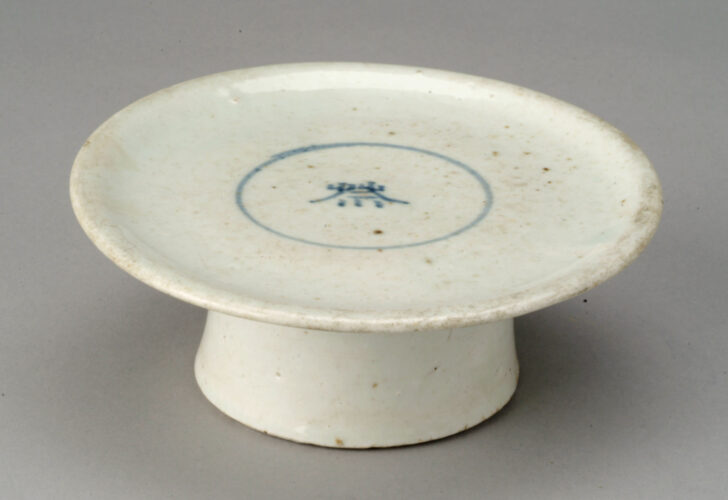Blue-and-white Ritual Dish with Inscription “Je (祭)”
Korean

Description
The upper surface of this dish features a circle with a Chinese character “je (祭)”, which means the “ancestral rite”. Written in a cobalt blue pigment, the character indicates that this dish was made in the purpose of being used in ritual for ancestors. Not only specifying its usage, the character’s simple lines and transparent color emit the feeling of dignity on the white surface of the ceramic, which is one of the prevalent characteristics of Joseon porcelain during the 18th century.
(Haely Chang, fall 2019)Confucian rituals for the veneration of ancestors were part of the life of all upper-class Koreans in the Joseon period. Simple white wares, often embellished with the Chinese character for “ritual,” were preferred for these occasions. Round dishes were used for offerings of fruits and vegetables, while square ones were used for cooked foods such as rice cakes, bean curd, or meats.
Maribeth Graybill, The Enduring Art of the Korean Potter, December 12, 2004-November 6, 2005
Physical Description:
The upper surface of this vessel features a circle with the Chinese character "je (祭: ancestral rite)" rendered inside in cobalt blue pigment. The tray features blemishes, while the rims show traces of use. The foot retains traces of coarse sand supports stuck to it during firing. This type of ritual vessel has been excavated from the upper sediment layers of waste deposits of kilns in front of what is now Bunwon-ri Elementary School in Gwangju-si, Gyeonggi-do. Such vessels are presumed to have been produced immediately before the Bunwon-ri kiln cloised down and to have been widely supplied to the general public.
[Korean Collection, University of Michigan Museum of Art (2014) p.196]
Usage Rights:
If you are interested in using an image for a publication, please visit https://umma.umich.edu/request-image/ for more information and to fill out the online Image Rights and Reproductions Request Form.